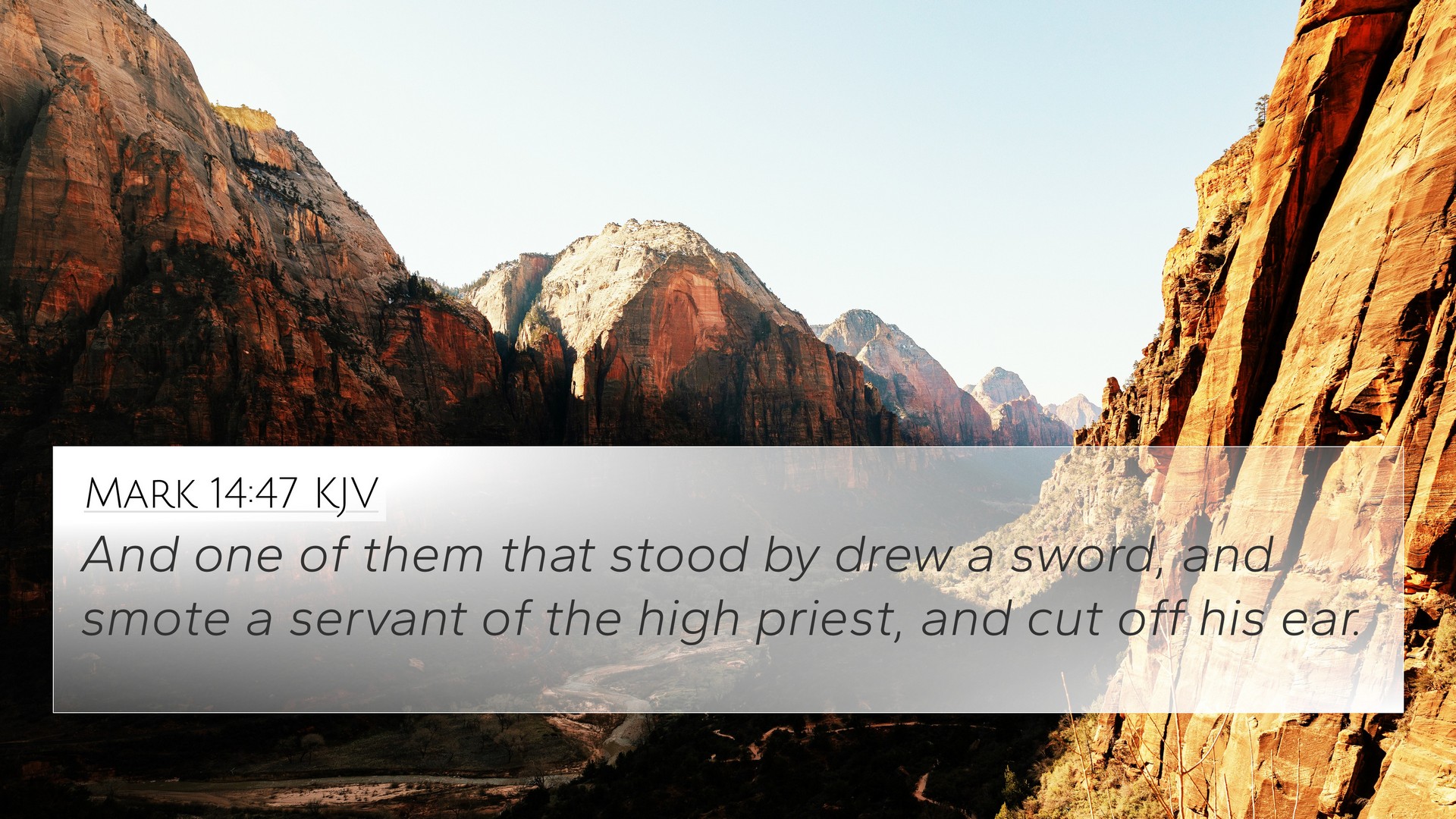Bible Verse Meaning and Interpretation: Mark 14:47
Mark 14:47 states, "And one of those who stood by drew his sword and struck the servant of the high priest and cut off his ear." This verse occurs during the arrest of Jesus, providing critical insight into the emotional and spiritual turmoil surrounding this pivotal moment.
Summary of Mark 14:47
This verse illustrates the intense atmosphere of fear and resolve among Jesus' followers, highlighting their struggle to comprehend the unfolding events. The impetuous action of the disciple is a reflection of loyalty and desperation, yet it contrasts sharply with Jesus' teachings of peace and restraint.
Insights from Public Domain Commentaries
- Matthew Henry: Henry emphasizes that the disciple's reaction was born out of human passion and a misunderstanding of the situation. Despite his intentions to protect Jesus, this act of violence contradicts the nature of Christ's mission. Henry points out this moment exemplifies the need for divine understanding over impulsive reactions.
- Albert Barnes: Barnes notes the identity of the disciple is traditionally understood as Peter, who often acted impulsively. He highlights how this incident illustrates the struggle between human fear and divine purpose, emphasizing that Jesus came to fulfill a higher calling rather than to wage war. Barnes encourages readers to reflect on how they respond to moments of crisis.
- Adam Clarke: Clarke suggests that the ear being severed may symbolize the consequence of rash decisions. He also brings attention to the mercy of Christ, who, despite the assault, later heals the servant, portraying a powerful message of forgiveness and peace. Clarke emphasizes the contrast between human retaliation and Jesus’ call for love even in hostility.
Connections and Cross-References
Mark 14:47 connects deeply with various other scriptures throughout the Bible, illustrating thematic parallels of violence, loyalty, and the teachings of Jesus. Below are important Bible cross-references related to this verse:
- Matthew 5:39: "But I say to you, Do not resist the one who is evil, but if anyone slaps you on the right cheek, turn to him the other also." This verse underscores Jesus' teaching against violent retaliation.
- Luke 22:51: "But Jesus said, 'No more of this!' And he touched his ear and healed him." This emphasizes Jesus’ response to violence and his commitment to healing and peace.
- John 18:10: "Then Simon Peter, having a sword, drew it and struck the high priest's servant and cut off his right ear." This provides additional context and identifies Peter’s actions specifically.
- Isaiah 53:5: "But he was pierced for our transgressions; he was crushed for our iniquities." This prophetic declaration highlights the sacrificial nature of Christ’s mission, contrasting the violence of Peter's action.
- Romans 12:19: "Beloved, never avenge yourselves, but leave it to the wrath of God, for it is written, 'Vengeance is mine, I will repay, says the Lord.'" This illustrates Christian teachings on the rejection of personal vengeance.
- 1 Peter 2:23: "When he was reviled, he did not revile in return; when he suffered, he did not threaten, but continued entrusting himself to him who judges justly." Peter himself later reflects on the proper response to violence.
- Matthew 26:52: "Then Jesus said to him, 'Put your sword back into its place. For all who take the sword will perish by the sword.'" This reinforces the call to refrain from violence.
Thematic Analysis
The themes in Mark 14:47 invite us to contemplate the nature of discipleship. The impulsivity seen in Peter's action is juxtaposed against the purposeful calm that Jesus exhibits throughout his arrest and crucifixion. This moment serves as a teaching point for followers about the responses to persecution and the fundamental principles Jesus preached about love and forgiveness.
Tools for Bible Cross-Referencing
For those interested in deeper studies, utilizing tools such as a Bible concordance or a Bible cross-reference guide can significantly enhance understanding of scriptures. These resources help in cross-referencing Bible studies and can assist in identifying connections between Bible verses, which deepen one’s insight into the themes and messages conveyed in the Bible.
Conclusion
Mark 14:47 serves as a profound reminder of the challenges faced by the early followers of Christ and the enduring lessons applicable to today's world. By engaging with interconnected scriptures, believers can uncover layers of meaning that inform their faith and practices. The exploration of this verse not only connects us to the immediate narrative in the Gospels but also ties into larger themes of redemption, mercy, and the call to embody Christ-like love even in the face of adversity.





